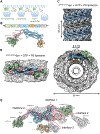Cryo-EM structures of membrane-bound dynamin in a post-hydrolysis state primed for membrane fission
- PMID: 38663399
- PMCID: PMC11265984
- DOI: 10.1016/j.devcel.2024.04.008
Cryo-EM structures of membrane-bound dynamin in a post-hydrolysis state primed for membrane fission
Abstract
Dynamin assembles as a helical polymer at the neck of budding endocytic vesicles, constricting the underlying membrane as it progresses through the GTPase cycle to sever vesicles from the plasma membrane. Although atomic models of the dynamin helical polymer bound to guanosine triphosphate (GTP) analogs define earlier stages of membrane constriction, there are no atomic models of the assembled state post-GTP hydrolysis. Here, we used cryo-EM methods to determine atomic structures of the dynamin helical polymer assembled on lipid tubules, akin to necks of budding endocytic vesicles, in a guanosine diphosphate (GDP)-bound, super-constricted state. In this state, dynamin is assembled as a 2-start helix with an inner lumen of 3.4 nm, primed for spontaneous fission. Additionally, by cryo-electron tomography, we trapped dynamin helical assemblies within HeLa cells using the GTPase-defective dynamin K44A mutant and observed diverse dynamin helices, demonstrating that dynamin can accommodate a range of assembled complexes in cells that likely precede membrane fission.
Keywords: clathrin-mediated endocytosis; cryo-EM; cryo-ET; dynamin; endocytosis; membrane fission; membrane remodeling; structural biology.
Copyright © 2024 Elsevier Inc. All rights reserved.
Conflict of interest statement
Declaration of interests The authors declare no competing interests.
Figures






Similar articles
-
Cryo-EM of the dynamin polymer assembled on lipid membrane.Nature. 2018 Aug;560(7717):258-262. doi: 10.1038/s41586-018-0378-6. Epub 2018 Aug 1. Nature. 2018. PMID: 30069048 Free PMC article.
-
Dynamin-like Proteins Combine Mechano-constriction and Membrane Remodeling to Enable Two-Step Mitochondrial Fission via a "Snap-through" Instability.J Am Chem Soc. 2025 Jul 16;147(28):24258-24274. doi: 10.1021/jacs.5c06352. Epub 2025 Jul 8. J Am Chem Soc. 2025. PMID: 40626390 Free PMC article.
-
A dynamin mutant defines a superconstricted prefission state.Cell Rep. 2014 Aug 7;8(3):734-42. doi: 10.1016/j.celrep.2014.06.054. Epub 2014 Jul 31. Cell Rep. 2014. PMID: 25088425 Free PMC article.
-
Building a fission machine--structural insights into dynamin assembly and activation.J Cell Sci. 2013 Jul 1;126(Pt 13):2773-84. doi: 10.1242/jcs.108845. Epub 2013 Jun 18. J Cell Sci. 2013. PMID: 23781021 Free PMC article. Review.
-
Dynamin: functional design of a membrane fission catalyst.Annu Rev Cell Dev Biol. 2011;27:79-105. doi: 10.1146/annurev-cellbio-100109-104016. Epub 2011 May 18. Annu Rev Cell Dev Biol. 2011. PMID: 21599493 Review.
Cited by
-
Nanoscale dynamics of Dynamin 1 helices reveals squeeze-twist deformation mode critical for membrane fission.Proc Natl Acad Sci U S A. 2024 Dec 3;121(49):e2321514121. doi: 10.1073/pnas.2321514121. Epub 2024 Nov 27. Proc Natl Acad Sci U S A. 2024. PMID: 39602273 Free PMC article.
-
Cryo-electron tomography pipeline for plasma membranes.Nat Commun. 2025 Jan 20;16(1):855. doi: 10.1038/s41467-025-56045-z. Nat Commun. 2025. PMID: 39833141 Free PMC article.
-
Efficiently determining membrane-bound conformations of peripheral membrane proteins using replica exchange with hybrid tempering: Orientation of PMP on lipid bilayer using replica exchange.Eur Phys J Spec Top. 2024 Dec;233(21-22):3039-3051. doi: 10.1140/epjs/s11734-024-01386-x. Epub 2024 Nov 1. Eur Phys J Spec Top. 2024. PMID: 40486818 Free PMC article.
-
Cryo-electron tomography pipeline for plasma membranes.bioRxiv [Preprint]. 2024 Jun 28:2024.06.27.600657. doi: 10.1101/2024.06.27.600657. bioRxiv. 2024. Update in: Nat Commun. 2025 Jan 20;16(1):855. doi: 10.1038/s41467-025-56045-z. PMID: 39372776 Free PMC article. Updated. Preprint.
-
The Structure of the Drp1 Lattice on Membrane.bioRxiv [Preprint]. 2025 Feb 19:2024.04.04.588123. doi: 10.1101/2024.04.04.588123. bioRxiv. 2025. Update in: J Mol Biol. 2025 Jun 15;437(12):169125. doi: 10.1016/j.jmb.2025.169125. PMID: 38617273 Free PMC article. Updated. Preprint.
References
Publication types
MeSH terms
Substances
Grants and funding
LinkOut - more resources
Full Text Sources
Research Materials

